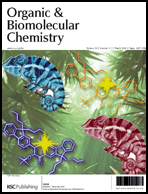The colourful images on our covers are from Andrew C. Benniston and Ming-Hua Xu et al.
Andrew Benniston (University of Newcastle) together with colleagues from Istanbul Technical University and Hacettepe University, Turkey have created a series of colour-responsive fluorescent fluorene-fused benzoquinones with potential for use as reactive oxygen species sensors. One of the compounds synthesised exhibits ‘chameleon-like’ behaviour switching from red to blue fluorescence on reduction, and reverts back to red on reaction with ROSs.
Colour-responsive fluorescent oxy radical sensors
Baris Yucel, Bahar Sanli, Huseyin Akbulut, Suheyla Ozbey and Andrew C. Benniston
DOI: 10.1039/C2OB06825G

Design of N-cinnamyl sulfinamides as new sulfur-containing olefin ligands for asymmetric catalysis: achieving structural simplicity with a categorical linear framework
Shen-Shuang Jin, Hui Wang, Ting-Shun Zhu and Ming-Hua Xu
DOI: 10.1039/C2OB06723D
This issue also contains a review on the recognition properties of imidazole derivatives by Franscico Otón et al. and a hot article from Luis Simón and Jonathan Goodman on hydrogen-bond stabilization in oxyanion holes, showing that the 3D arrangement, rather than planar arrangement, of H-bonds stabilises oxyanion holes.











